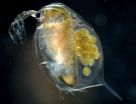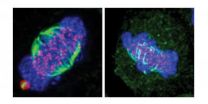(Press-News.org) An international group of scientists has proposed that fallout from hundreds of nuclear weapons tests in the late 1940s to early 1960s could be used to mark the dawn of a new geological age in Earth history - the Anthropocene.
The study, led by Dr Colin Waters of the British Geological Survey, published new research in the Bulletin of the Atomic Scientists. The research involved 10 members of the Anthropocene Working Group that is chaired by Professor Jan Zalasiewicz of the Department of Geology at the University of Leicester and Gary Hancock, a world expert on plutonium in the environment.
The researchers state that the mid-twentieth century coincides with the 'Great Acceleration' of human population growth, economic development and industrialization. The emergence of megacities, facilitated by the production of huge quantities of concrete, is coincident with earth movement on a vast scale. Mineral exploitation has resulted in the generation of marked geochemical signatures across the globe and this age of hydrocarbon burning has resulted in greatly increased carbon emissions. Humanity's modification of the planet has caused an increase in species extinctions and invasions. All these features are being expressed in the sediments accumulating across the planet and will be recognizable to the geoscientists of the far future.
They pose the question: "If the sum of these changes is a recognition that we now live in a new epoch, the Anthropocene, how can we define when it started?"
The standard practice for defining geological time units is to identify a single reference point (or "golden spike") that fixes the lower boundary of the time unit within a succession of rock or sediment layers. The boundary should be characterized by a signature that is both rapidly developed and wide-spread. The proposal led by Dr Waters is that the programme of atmospheric nuclear weapons testing may have generated such a signature.
Dr Waters said: "It is sobering to think that the actions of humanity over a few short years in the mid-20th century created such large amounts of artificial radionuclides that scattered across the Earth as fallout, producing a signal in modern strata that, in the case of plutonium, will be a detectable for about 100,000 years into the future".
Starting with the 1945 detonation of the Trinity device in New Mexico, the extent of such fallout was initially quite localized. But with the introduction in 1952 of the much larger "thermonuclear" or "hydrogen" weapons tests, the fallout dispersed over the entire Earth surface. The amount of fallout peaked in 1962, the year before the Partial Nuclear Test-Ban Treaty largely drove the nuclear detonations underground. The 1952 rise in abundance of the isotope plutonium-239 is preferred as it is rare in nature, is a significant component of fallout, is relatively immobile in sediments, has a long half-life so will persist long into the future and the rise is broadly coincident with the onset of the "Great Acceleration".
Professor Zalasiewicz said: "The Anthropocene has struck a chord in the wider world that none of the other geological time units have done - not even the dinosaur-haunted Jurassic. Human beings don't merely inhabit the world. They alter it, on an increasingly epic scale."
In 2016, the Anthropocene Working Group hopes to make recommendations on whether this new time unit should be formalized and, if so, how it might be defined and characterized.
INFORMATION:
For further information contact: Dr. Colin Waters cnw@bgs.ac.uk or Professor Jan Zalasiewicz jaz1@le.ac.uk
You can access the article here: http://thebulletin.org/2015/may/can-nuclear-weapons-fallout-mark-beginning-anthropocene-epoch8295
Reference
Waters, C.N., Syvitski, J.P.M., Ga?uszka, A., Hancock, G.J., Zalasiewicz, J., Cerreata, A., Grinevald, J., Jeandel, C, McNeill, J.R., Summerhayes, C., Barnosky, A. Published online. Can nuclear weapons fallout mark the beginning of the Anthropocene Epoch? Bulletin of the Atomic Scientists. Vol. 71(3) 46-57
The following institutions are represented on the paper:
British Geological Survey, Keyworth, Nottingham NG12 5GG, UK
University of Colorado-Boulder Campus, Box 545, Boulder, CO 80309-0545, USA
Geochemistry and the Environment Division, Institute of Chemistry, Jan Kochanowski
University, 15G ?wi?tokrzyska St, 25-406 Kielce, Poland
CSIRO Land and Water, Canberra, ACT 2601, Australia
Department of Geology, University of Leicester, University Road, Leicester LE1 7RH, UK
Departamento de Estratigrafía y Paleontología, Facultad de Ciencia y Tecnología, Universidad del País Vasco UPV/EHU, Apartado 644, 48080 Bilbao, Spain
IHEID, Chemin Eugène Rigot 2 , 1211 Genève 11, Switzerland
CNRS, LEGOS, 31400 Toulouse, France
Georgetown University, Washington, DC, USA
Scott Polar Research Institute, Cambridge University, Lensfield Road, Cambridge CB2 1ER, UK
Dept. of Integrative Biology, Museum of Paleontology, Museum of Vertebrate Zoology, University of California, Berkeley, CA 94720, USA
May 11, 2015 - What are the most influential studies on surgery of the lower (lumbar) spine? The "top 100" research papers in lumbar spine are counted down in a special review in the May 15 issue of Spine, published by Wolters Kluwer.
Dr. Samuel K. Cho and colleagues of Icahn School of Medicine at Mount Sinai, New York City, performed a literature review to analyze and quantify the most important research papers on lumbar spine surgery. Their results raise some interesting "questions, trends and observations"--including the finding that the two most-cited studies ...
The water flea has genetically adapted to climate change. Biologists from KU Leuven, Belgium, compared 'resurrected' water fleas -- hatched from 40-year-old eggs -- with more recent specimens. The project was coordinated by Professor Luc De Meester from the Laboratory of Aquatic Ecology, Evolution and Conservation.
The water flea has genetically adapted to climate change. Biologists from KU Leuven, Belgium, compared 'resurrected' water fleas - hatched from forty-year-old eggs - with more recent specimens. The project was coordinated by Professor Luc De Meester from the ...
What does space experimentation have in common with liquid cocktails? Both help in understanding what happens when multiple fluids are mixed together and subjected to temperature change - a phenomenon ubiquitous in nature and industrial applications such as oil fluids contained in natural reservoirs. The latest experimental data performed in zero gravity on the International Space Station is now available in the newly published Topical Issue of EPJ E. The results constitute the first set of highly accurate and broadly validated data on the thermodiffusion effects that occur ...
MADISON -- Mike Graham knows that fluid dynamics can reveal much about how the flow of blood helps and hinders individual blood cells as they go about their work.
Graham, the Vilas Distinguished Achievement Professor and Harvey D. Spangler Professor of Chemical and Biological Engineering at UW-Madison, established a theoretical basis for these ideas by creating complex computer stimulations that show how relatively stiff white blood cells and platelets interact with more flexible red blood cells. As the different cells collide during blood flow, white cells tend to be ...
Volcanoes are considered chaotic systems. They are difficult to model because the geophysical and chemical parameters in volcanic eruptions exhibit high levels of uncertainty. Now, Dmitri V. Alexandrov and colleagues from the Ural Federal University in Ekaterinburg, in the Russian Federation, have further extended an eruption model -- previously developed by other scientists -- to the friction force at work between the volcanic plug and volcanic conduit surface. The results, published in EPJ B, provide evidence that volcanic activity can be induced by external noises that ...
Chinese scientists have reared beef rich in the beneficial fatty acids associated with fish oils. The study in Springer's journal Biotechnology Letters also highlights the scientific challenges that remain.
The team from Northwest A&F University and the National Beef Cattle Improvement Centre, both in Yangling (Shaanxi), successfully introduced a gene into foetal cells from Luxi Yellow cattle, a Chinese breed with a high beef yield. The fat1 gene, isolated from a nematode worm, codes for desaturase enzymes that are involved in the conversion of n-6 to n-3 polyunsaturated ...
How much food your dining companion eats can have a big influence on how much you consume, a UNSW Australia-led study concludes.
This psychological effect, known as social modelling, leads people to eat less than they normally would if alone when their companion consumes a small amount of food.
Study lead author, Associate Professor Lenny Vartanian of the UNSW School of Psychology, says that in social situations the appropriate amount of food to eat can be unclear.
"Internal signals like hunger and feeling full can often be unreliable guides. In these situations people ...
An international consortium of scientists led by a group from the University of Leicester has announced a new advance in understanding the mechanisms of cancer and how to target it more effectively with new treatments.
Two papers published in the same issue of the world-leading Journal of Cell Biology have arisen from research work led by Professor Andrew Fry at the University of Leicester. Both papers suggest that new understanding of the mechanics of cell division can reveal new targets for cancer therapy.
Professor Fry, who is Director of Research in the College ...
Geoscientists have, for the first time, discovered the origins of Australia's two largest basins: Lake Eyre and the Murray-Darling Basin. The research also implies that in 30 million years' time both basins will cease to exist.
Monash University geoscientist Associate Professor Wouter Schellart, and his colleague Professor Wim Spakman from Utrecht University, have discovered how the floor of an entire ocean basin that was destroyed 70 to 50 million years ago off the North coast of New Guinea is currently located at 800-1200km depth below Central and South-eastern Australia.
Using ...
New scanning methods which map the wiring of the brain could provide a valuable new tool to predict people at risk of schizophrenia, according to a new study.
Scientists have long known that the symptoms of schizophrenia are partly explained by disordered connectivity in the brain.
Now, a team of scientists from Cardiff University Brain Research Imaging Centre (CUBRIC), the Institute of Psychiatry, Psychology and Neuroscience, Kings College London and the University of Bristol, have, for the first time, used Magnetic Resonance Imaging (MRI) to identify how the ...

